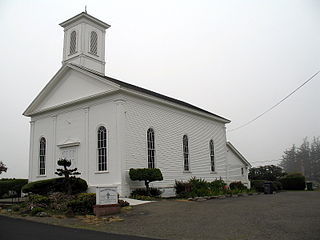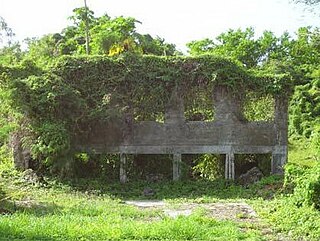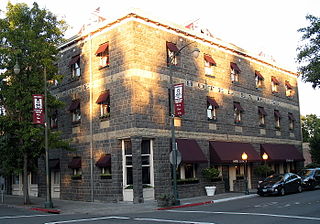
The Salinas Pueblo Missions National Monument is a complex of three Spanish missions located in the U.S. state of New Mexico, near Mountainair. The main park visitor center is in Mountainair. Construction of the missions began in 1622 and was completed in 1635.

Pecos National Historical Park is a United States National Historical Park in San Miguel and Santa Fe Counties, New Mexico. The park, operated by the National Park Service, encompasses thousands of acres of landscape infused with historical elements from prehistoric archaeological ruins to 19th-century ranches, to a battlefield of the American Civil War. Its largest single feature is Pecos Pueblo also known as Cicuye Pueblo, a Native American community abandoned in historic times. First a state monument in 1935, it was made Pecos National Monument in 1965, and greatly enlarged and renamed in 1990. Two sites within the park, the pueblo and the Glorieta Pass Battlefield, are National Historic Landmarks.

El Presidio Real de Santa Bárbara, also known as the Royal Presidio of Santa Barbara, is a former military installation in Santa Barbara, California, United States. The presidio was built by Spain in 1782, with the mission of defending the Second Military District in California. In modern times, the Presidio serves as a significant tourist attraction, museum and an active archaeological site as part of El Presidio de Santa Barbara State Historic Park.

This is a list of the buildings, sites, districts, and objects listed on the National Register of Historic Places in Guam. There are currently 134 listed sites spread across 17 of the 19 villages of Guam. The villages of Agana Heights and Mongmong-Toto-Maite do not have any listings. Listed historic sites include Spanish colonial ruins, a few surviving pre-World War II ifil houses, Japanese fortifications, two massacre sites, and a historic district. Two other locations that were previously listed have been removed from the Register.

The James C. Flood Mansion is an historic mansion at 1000 California Street, atop Nob Hill in San Francisco, California, USA. Now home of the Pacific-Union Club, it was built in 1886 as the townhouse for James C. Flood, a 19th-century silver baron. It was the first brownstone building west of the Mississippi River, and the only mansion on Nob Hill to structurally survive the 1906 San Francisco earthquake and fire. It was declared a National Historic Landmark in 1966.

The San Buenaventura Mission Aqueduct was a seven-mile long, stone and mortar aqueduct built in the late 18th and/or early 19th century to transport water from the Ventura River to the Mission San Buenaventura in Ventura, California.

The Iglesia de San Carlos Borromeo is a historic church built in 1783, located on the plaza of Aguadilla, Puerto Rico. It was listed on the U.S. National Register of Historic Places in 1984.

The Iglesia San Germán de Auxerre is a historic Roman Catholic parish church located in San Germán, Puerto Rico, overlooking the main plaza of the town. Spanish settlers founded San Germán parish in 1510 and built the first permanent church in 1688. The church was repaired and reconstructed between 1717 and 1739 after it suffering earthquake damage. Between 1834 and 1897, new repairs were made to the building, and in 1920, the tower was rebuilt after the 1918 earthquake. With trompe-l'œil painting that imitates wood coffers on the ceiling, the Church of San Germán's interior is one of the most lavishly decorated on the island. The vault and arches are painted in the trompe-l'œil manner. The church conserves the 1869 marble altar as well as ten other 19th century smaller secondary marble altars. A collection of 17th century metalwork, 18th century wooden carvings and a painting by José Campeche are kept in the choir loft. It was listed on the National Register of Historic Places in 1984.

The First Baptist Church, also known as the Bell Towers, is a historic church complex built in 1931 in Bakersfield, California and presently used as an office building. The structure was placed on the National Register of Historic Places (NRHP) on January 2, 1979.

Trinity Presbyterian Church, known from 1972 on as Mission United Presbyterian Church, is a historic Presbyterian church at 3261 23rd Street in the Mission District of San Francisco, California.

The Tomales Presbyterian Church and Cemetery, at 11 Church Street in Tomales, California, was listed on the National Register of Historic Places in 1975.

San Antonio de Padua Church is a historic church along State Road 63 in Pecos, New Mexico. It was built during 1903 to 1906 and added to the National Register of Historic Places in 1978.

The Agana Spanish Bridge is a stone arch bridge built in 1800 in Hagåtña, Guam, during the administration of Spanish governor Manuel Muro. It is the only surviving Spanish bridge in Hagåtña, which is the capital of the United States territory of Guam. Also known as Sagon I Tolai Acho, it is located at the southwest corner of Aspenall St. and Rte. 1 and was listed on the U.S. National Register of Historic Places in 1974.
Toves House, on Marine Dr. in the Anigua district of Hagåtña, Guam, was built in 1950, built mostly with ifil hardwood. It was a work of Pedro T. Toves in Pacific Spanish-Colonial vernacular architecture. It was listed on the National Register of Historic Places in 1985.
The Agana Historic District in Hagåtña, Guam is a 2-acre (0.81 ha) historic district that was listed on the U.S. National Register of Historic Places in 1985. It includes five contributing buildings: the Calvo-Torres, Rosario, Martinez-Notley, Lujan and Leon Guerrero houses. The area is roughly bounded by 2nd S., 3rd S., and 9th W., Santa Cruz and Legaspi Sts. in Agana.

Fort Santa Agueda, on Guam Highway 7 in Hagåtña, Guam, dates from about 1800, during the 1784-1802 administration of Spanish governor Manuel Moro. It was an uncovered fort with a manposteria parapet, rising about 10 feet (3.0 m) above a sloping hillside. It is listed on the U.S. National Register of Historic Places, as the only remaining fortification of the Spanish Era in Hagåtña.

The Guam Cable Station is where the United States territory of Guam was first connected via modern telecommunications to the rest of the world. Reduced to ruins by the fighting of World War II, the ruins of the establishment remain on the grounds of Naval Base Guam on the west side of the island.
Fort San Jose is a former Spanish fortification on the island of Guam, now a United States territory. It is located north of the village of Umatac, on a hill over looking both Fouha Bay and Umatac Bay, the place were Spanish galleons traveling between Manila in the Spanish Philippines and Acapulco, Mexico stopped for water and supplies.
The Francisco Q. Sanchez Elementary School is a historic school building on the north side of Guam Highway 2 in Umatac, Guam. It is a single-story International style structure, with two classroom wings flanking a central administration area. The building was designed by noted Internationalist architect Richard J. Neutra, and built in 1953 adjacent to the San Dionisio Church Ruins. Neutra's design sought to integrate the school with its surrounding environment, and provides a panoramic view of Umatac Bay. The building is one of four buildings built pursuant to a master plan developed by Neutra and Robert J. Alexander. It is Umatac's only school.

The Hotel La Rose, at 5th and Wilson Sts. in Santa Rosa, California, was built in 1907, as a replacement for a predecessor building destroyed in the 1906 San Francisco earthquake. It was listed on the National Register of Historic Places in 1978.


















